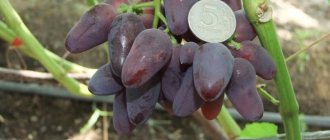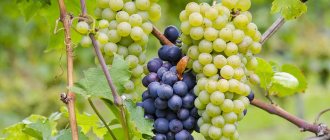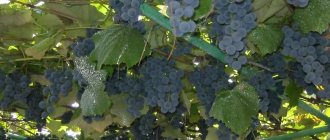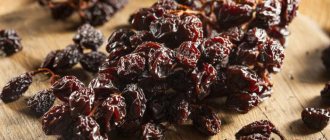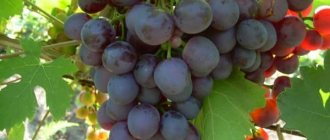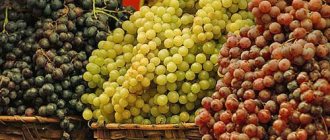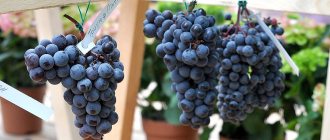Recently, grape varieties with black berries have become increasingly popular. This can largely be explained by the fact that red (black) grape varieties contain many vitamins (in particular the PP group) in larger quantities than white or pink ones . A huge number of summer residents plant multi-colored varieties, if only because they really want to make their garden more interesting, so to speak, so that it has color contrasts.
Next, you will not only learn, but also see which black grape varieties have gained the greatest popularity and recognition among winegrowers.
Introduction
Black grapes will become a bright accent in any country house.
In addition to its decorative appearance, it will delight the owner with delicious berries, which can be used both for fresh consumption and for making desserts or homemade wine.
If you are looking for a suitable grape variety to grow on your own plot, we suggest you familiarize yourself with our selection.
Overview of varieties
The varieties of black grapes presented in the rating alphabetically will help novice gardeners decide on the choice of a suitable crop for their plot.
Alden
Let's start looking at black grape varieties, variety descriptions, and photos with Alden. Medium early culture. The berries ripen around the twentieth of August. The clusters are small, the average weight is from 300 to 400 g. The shape of the brush is conical. The berries do not fit tightly together. The shape of the berry is round, slightly elongated. The weight of one fruit is about 6 g. The skin is dense when ripe and acquires a dark purple color.
The pulp is tender, juicy, but there are few mucous substances. The taste and aroma resembles the famous variety Isabella. The berry contains sugar – 21 g/100 cm3, acid – 6 g/cm3. The vine manages to ripen within a season. The bushes are vigorous with 96% of fruit-bearing shoots. The variety can withstand temperatures down to –27°C. The culture is resistant to fungal diseases. The purpose of the berries is universal. Grapes are usually eaten fresh or used for wine.
Advice! For better yield, pruning of the vines on the bush is carried out with 4–6 buds.
Athos
A new grape variety with black berries was developed recently, but has already taken root among many domestic gardeners. By origin, Athos is considered a hybrid. The parents are two popular varieties: Codryanka and Talisman. According to the timing of ripening, the grapes are considered early. Harvesting begins 100 days from the moment the buds awaken. After ripening, the brushes are able to hang on the vine for about a month without losing their presentation. However, the berries do not attract wasps.
The fruits and clusters are large. The weight of one bunch reaches 1.5 kg. The shape of the fruit is cylindrical, elongated with a thin nose. The grapes are very sweet. When eaten, you hardly feel the acid. The berries are not subject to peas.
The vine grows quickly. The bush must be constantly shaped to prevent thickening. The grapes are resistant to all fungal diseases, except gray rot. Winter hardiness is good. The vine can withstand frosts down to – 24°C.
Baz
When looking for varieties of black wine grapes, it is worth stopping at the American hybrid Baz. The culture was developed by crossing Chasselas rosea and Mills. The variety is quite old. Year of origin: 1962. The berries ripen at the end of September. Baz table grapes are already rare in their homeland and are preserved only by private gardeners. The culture is practically not affected by fungal diseases. The shape of the berries is spherical. The pulp is juicy with a delicious taste.
Balabanovsky
The parents of the mid-early black grape variety are Wilder and Hamburg Muscat. The ripening of the crop begins 125 days from the moment the buds open. Typically, harvesting time falls at the end of August. The vine is vigorous, the bushes are spreading. The clusters grow small, weighing a maximum of 150 g. The shape of the bunch is indefinite, sometimes similar to a cylinder. The berries are not collected tightly. The weight of one fruit is about 5 g. The shape of the berry is round.
The pulp of black grapes is very slimy. The taste is dominated by strawberry aroma. The skin is quite durable. The variety can rightfully be called black wine grapes, since small berries are rarely used fresh for consumption. The fruit pulp contains sugar 21 g/100 cm3 and acid 9 g/dm3. The vine is cut into 5 eyes. The bushes can withstand frosts down to – 27°C. The total load on the bush is a maximum of 40 buds.
Important! The Balabanovsky variety combines well with rootstocks.
Delight black
Considering the description and photo of black grape varieties, we will focus on the mid-early crop, the grapes of which begin to ripen on the 125th day. The brushes are large and cylindrical in shape. The berries are spherical, slightly elongated, tightly collected in clusters. The bushes are vigorous. For the vine to fully develop, you need a lot of free space. During the season, the lashes have time to ripen.
With good care, the first cluster may appear as early as the second year after planting a grape seedling. The bush produces only female flowers. For fertilization, another pollinator variety must be planted nearby. The grape yield reaches 200 c/ha. The vine is not affected by mildew and oidium, but is afraid of gray rot. The bushes can withstand frosts down to – 25°C. In cold regions, the vine is covered for the winter.
Giovanni
The handsome Giovanni presents the varieties of early black grapes. The berries ripen 100 days after bud break. The clusters are large, weighing about 1.2 kg. The color of the fruit is dark cherry. The berries are cylindrical, very elongated. The taste is dominated by nutmeg aroma. The skin is medium thick, but not very hard when chewed.
Codrianca
The early grape variety is ready for harvest 110 days after bud break. The bunches grow in different sizes, weighing from 0.4 to 1.5 kg. The berries are large, oval, highly elongated. The fleshy pulp is highly saturated with juice. Sugar content is about 19%.
Black grape bushes are characterized by strong growth. The vine manages to ripen within a season. The variety has average resistance to oidium, mildew and other diseases. The vine can withstand temperatures as low as –22°C. It is better to grow the variety in the southern regions or take care of good shelter for the winter.
Important! The Codryanka grape variety is prone to peas. Phytohormones help combat the problem.
Cabernet Sauvignon
Considering late black grape varieties, photos and descriptions, it is worth paying attention to Cabernet Sauvignon. The culture is high-yielding. The fruits are good for making wine. The variety is resistant to severe frosts and is rarely affected by fungal diseases. The shape of the berries is spherical. The fruits are tightly collected in clusters. The dark blue skin of the berry is covered with a white coating. The juicy pulp has virtually no color. Coloring pigments are contained in the skin. The taste of the berries is nightshade.
Merlot
Merlot is a worthy representative of the group of black wine grapes. The brushes ripen early, approximately 100 days after the foliage begins to bloom. The popularity of grapes is given by the good frost resistance of the vine. Bushes are rarely affected by diseases. Ripe berries turn black and blue. The skin is covered with a white coating. The pulp is slimy, transparent with a lilac tint. The blue pigment is found in the skin of the fruit.
Muscat of Hamburg
Even if you just look at a photo of the black Muscat Hamburg grape, you can conclude that the variety is large-fruited. The brushes grow in the shape of a cone. The berries are dark blue with a black tint. The skin is covered with a white coating. The ripening of the brushes begins in the last days of July. At the beginning of August you can harvest the crops.
The clusters weigh on average about 750 g. The pulp of the berries contains about 20% sugar. The vine tolerates wintering well. Grapes love feeding with ash.
Odessa souvenir
When looking for the best tasty varieties of black grapes, it is worth trying to grow Odessa Souvenir. However, the culture is more popular among gardeners in the southern regions. Late variety. The ripening of grape berries begins 145 days after the leaves begin to bloom. In the south, the vine has time to fully ripen before the onset of cold weather. The bushes are compact, the vine grows with medium intensity.
The clusters grow of medium size, but are compensated by large berries. The fruits are oval, elongated. The juicy pulp contains up to 16% sugar. The grape is famous for its pleasant muscat taste with a hint of sloe. The yield indicator is 100 c/ha. Bushes are rarely affected by mildew or gray mold.
Attention! The Odessa Souvenir variety is susceptible to oidium.
Odessa black
The late-ripening black grape variety is more suitable for growing in the southern regions. In the northern regions, brushes and young lashes will not have time to mature. Bush of medium height. The grapes produce bisexual flowers, which eliminates the need to plant a pollinator nearby.
The berries are small, spherical in shape. The thick skin on top is covered with a white coating. The pulp is slimy and juicy. The taste has a cherry aroma with a hint of sloe. The bushes winter well and are rarely exposed to diseases.
Attention! The Odessa black variety is intended for making sparkling wine and juice.
Original black
The black grape variety is considered a medium-late crop in terms of ripening. Depending on weather conditions, the crop is ready for harvesting in 135–150 days. The brushes grow weighing about 0.9 kg. The fruit is elongated in the form of a cone with a rounded thin nose. The berry weighs about 10 g.
There is little sugar in the pulp, but the fruits are very tasty. The bunches picked from the bush can be stored, but the berries crack during transportation. The vine can withstand temperatures down to –24°C. The bushes are spreading and growing strongly. The shoots have time to ripen within a season.
Video review of the Original black variety:
Pinot Noir
The late variety of black grapes ripens 150 days from the moment the buds awaken. The bushes tolerate wintering well. The grape variety is distinguished by a rounded leaf shape with a wrinkled surface. The berries are small, spherical, sometimes slightly elongated. The skin is dark blue with a faint white coating. The variety is very capricious to grow. Grapes love cool weather and grow better on gentle slopes.
Black Pearl
According to the ripening period, the variety is considered mid-early. In the southern regions, the harvest is harvested from the third ten days of August and throughout September. The clusters are small, weighing about 500 g. The berry is round in shape, small. The fruits are used to make wine. The bushes are able to survive frosty winters, but are susceptible to fungal diseases. For prevention, grapes are treated with fungicides.
Reviews from gardeners
Novikov Sergey
Slavyansk, amateur winegrower
Black emerald ripens very early and produces a large harvest. The bushes are vigorous, the berries have a crispy and very tasty pulp. I also like the appearance of the bush. In addition, in the fall its leaves turn red quite early.
Popov Gennady Petrovich
Volgograd, winegrower with 16 years of experience
Wine grape varieties need preventive treatment in the same way as table grapes. Although the merlot grapes had time to ripen, by autumn the leaves began to suffer from oidium. When I normalized the bushes by a quarter, the berries grew larger, and it became easier to separate them from the ridge when making homemade wine. Merlot makes a great drink, a little tart and fruity. So on holidays we only drink homemade wine.
Svetlana Minina
Odessa, winegrower with 5 years of experience
Rochefort is an excellent variety that grows well. Disease resistance is even higher than stated. The berries are very large, dense, crispy. The clusters can hang quietly on the bush for 2 months.
Beneficial properties of black grapes
As can be seen from the composition, a culture so rich in substances necessary for the human body is extremely useful. What exactly? Let's try to figure it out.
- It has long been known that the berries of chokeberry grape varieties contribute to the effective removal of excess salt from the body. This makes black grapes an indispensable remedy for the treatment of diseases such as arthritis, gout or rheumatism;
- By regularly eating grapes with black berries, you can prevent the formation and growth of stones in the bladder, kidneys, and gall bladder;
- the substances contained in black grapes contribute to the effective dilution of viscous, difficult to separate sputum, which often appears in a number of respiratory tract diseases;
- psychologists advise their patients black grapes for stress and depression;
- a bunch of black grapes prevents hormonal disorders (and helps to heal existing ones), strengthens weakened immunity;
- the magnesium, potassium and calcium contained in this culture have a positive effect on the functioning of the heart and blood vessels;
- black grape varieties are considered natural antioxidants that, when consumed regularly, can significantly reduce the likelihood of developing benign and even malignant tumors;
- Daily consumption of black grapes improves brain function, memory, concentration and reaction speed, which means that those who love this delicacy are not at risk of Alzheimer's.
Currently reading: White extra-early Muscat: characteristics of the variety and cultivation
And yet, with all the beneficial properties of black grapes, it is still undesirable to get carried away with them beyond measure, and even more so you should not consider them something like a panacea for any disease. Treat it like a healthy treat: eat regularly, but little by little, and a positive result will not be long in coming.
Vitamins and minerals
| Vitamin name | Quantity (per 100 g) | % of daily value |
| Beta-carotene | 0.039 mg | 0,8 |
| Vitamin A (VE) | 3 mcg | 0,3 |
| Vitamin B1 (Thiamin) | 0.069 mg | 4,6 |
| Vitamin B2 (Riboflavin) | 0.07 mg | 3,9 |
| Vitamin B4 (Choline) | 5.6 mg | 1,1 |
| Vitamin B5 (Pantothenic Acid) | 0.05 mg | 1 |
| Vitamin B6 (Pyridoxine) | 0.086 mg | 4,3 |
| Vitamin B9 (Folic Acid) | 2 mcg | 0,5 |
| Vitamin K (Phylloquinone) | 14.6 mcg | 12,2 |
| Vitamin C (Ascorbic Acid) | 10.8 mg | 12 |
| Vitamin E (Tocopherol) | 0.13 mg | 1,3 |
| Vitamin PP (Niacin Equivalent) |
Grape berries also contain many valuable minerals that have a beneficial effect on the body:
| Element | Quantity (per 100 g) |
| Calcium | 10 mg |
| Magnesium | 7 mg |
| Sodium | 2 mg |
| Zinc | 0.07 mg |
| Potassium | 191 mg |
| Copper | 127 mcg |
| Manganese | 0.071 mg |
| Phosphorus | 20 mg |
| Selenium | 0.1 mcg |
| Iron | 0.36 mg |
| Fluorine | 7.8 mcg |
Reasonable introduction of black grape berries into the diet will help improve the general condition of the body and will have a general strengthening effect on the cells of the body.
Grapes are in demand among buyers almost all year round. And this is not surprising - with such diversity, everyone can find “something of their own.” It can have different characteristics, ranging from color (from light shades to black) and taste (sour, sweet, sour-sweet) and ending with some secondary properties (for example, suitability for making wine). Many gardeners try to grow several varieties of both white and crops with dark berries. Each type has its own advantages, and discussing them would take too much time, so this article will be devoted only to black grapes, a review of its most popular varieties, and the beneficial properties of this plant.
On average, white and red species are more common than black, although it is actually in no way inferior to them, and the requirements for cultivation are also not very different. Black predominates only in areas where industrial winemaking is established. Some varieties of this crop can grow wild in nature. In addition to being used for winemaking, black grapes are often consumed fresh, less often in frozen and dried form. The last two options are not so bad in terms of nutrients, because this type will be useful for any method of consumption.
One of the most important properties of black grapes (although this applies to all types of crops) is their effect on the cardiovascular system, specifically preventing blood clots and maintaining the strength and flexibility of the arteries. Regular consumption of black grapes keeps blood pressure and cholesterol levels normal.
It's no secret that black grapes contain many different substances. Among the vitamins, the most abundant are C and K (strengthen the immune system), beta-carotene (beneficial for vision), as well as several other types of vitamins, glucose, fructose and dozens of substances present in small quantities. It also contains a lot of antioxidants, the main function of which is to protect the plant from bacteria and fungi. In the human body, they block the occurrence of inflammatory processes and improve well-being in chronic ailments. Monosaccharides help remove waste and toxins from the body. Small portions every day will help replenish the body with macro- and microelements, in particular potassium, magnesium, calcium; zinc, iron, and selenium are present in small quantities.
Black grapes bring benefits not only when taken internally. Even the ancient Egyptians knew about the positive effects of grapes on the skin. Some active components found in fruits make the skin firm and elastic, and cosmetologists have skillfully taken advantage of this. For example, on the shelves you can see many cosmetics with black grape extract.
Is it possible for everyone?
We already know about the general health benefits of berries. But there are certain "risk groups" - conditions under which you should pay special attention to your diet.
For example, during pregnancy and breastfeeding, with diabetes, as well as in childhood, many necessary and valuable substances may turn out to be useless and even dangerous. Let's see if this applies to grapes.
Pregnancy
Although many experts recommend that pregnant women stop eating grapes , these precautions have nothing to do with the official position of the Global Health Company.
Essentially ! During pregnancy, as well as during breastfeeding, alcohol is definitely contraindicated and red wine, known for its benefits to the body, is not allowed during pregnancy.
But the freshest berries and good juice (without preservatives or dyes) can and should be consumed at this stage. It is important not to overuse the product (given the high calorie content) and to ensure that allergic reactions do not occur.
Note that you should not be afraid to eat allergenic foods to avoid allergies.
Recent studies have shown that between these actions there is not only a direct connection, but also a feedback: the faster a child becomes familiar with an allergen, the faster he becomes protected from it.
And one more precaution: the expectant mother should eat grapes separately from other fruits, heavy foods, as well as milk, mineral water and kvass, since such compositions are very difficult for the stomach and can cause fermentation processes in the intestines.

